Speechmatics is setting new standards in speech-to-text technology, solving critical communication challenges businesses across various industries face. As someone who has evaluated multiple transcription solutions, I recognize the increasing need for tools that deliver exceptional accuracy in multiple languages.
Studies show that over 70% of companies cite language diversity as a communication barrier, highlighting the importance of reliable transcription systems.
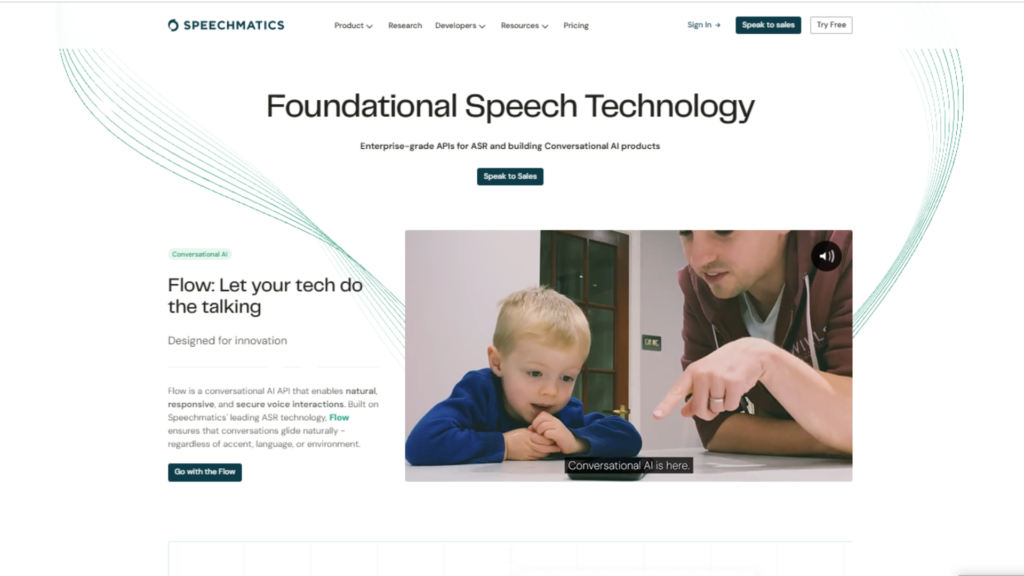
This review will explore how Speechmatics delivers precision and scalability, supporting over 30 languages and dialects to meet diverse organizational needs. Whether used in media, education, or customer support, this solution aims to transform the way businesses process audio data.
By examining its features, real-world applications, and competitive positioning, you’ll gain insights into its performance and whether it aligns with your requirements. Let’s unpack the capabilities of this innovative tool to see if it’s the right match for your objectives.
What is Speechmatics?
Speechmatics is speech-to-text software that efficiently converts spoken language into written text with high accuracy.
It uses advanced machine learning models to process audio and video files, delivering real-time transcriptions or on-demand. The software supports over 30 languages and dialects and is well-suited for users with diverse linguistic needs.
Core Functionality and Purpose
Speechmatics focuses on simplifying transcription processes by converting audio inputs into structured text. It can handle various accents, adjust to background noise, and identify different speakers in a conversation using speaker diarization.
Its capabilities include creating captions, transcribing meetings, and analyzing recorded conversations. The tool aims to provide reliable transcription that helps businesses and professionals manage audio content effectively, improve accessibility, and save time in documentation efforts.
Features such as punctuation recognition and customizable vocabularies make it adaptable to various industries and workflows.
Who Is Speechmatics Designed For?
Speechmatics serves a wide range of users across industries:
- Media and Broadcasting: Ideal for creating transcripts, captions, and subtitles.
- Education: Useful for converting lectures and discussions into text.
- Legal and Compliance: Suitable for documenting court proceedings and compliance-related interactions.
- Customer Service and Call Centers: Helps analyze conversations and improve operational efficiency.
Its adaptability makes it valuable for all, from startups to large enterprises, and for professionals who frequently work with audio or video content, such as podcasters, content creators, and transcription services.
Unique Selling Points and Key Benefits
Speechmatics distinguishes itself through:
- Language Support: Extensive coverage of over 30 languages and dialects.
- Accuracy: The system is trained on diverse datasets, allowing it to handle various speech patterns effectively.
- Speaker Identification: Identifies and separates contributions from multiple speakers in a recording.
- Noise Adaptation: Delivers reliable results even in challenging audio environments.
- Integration Flexibility: Works seamlessly with other tools and workflows using APIs.
By addressing common challenges like transcription accuracy and scalability, Speechmatics helps organizations optimize their operations, manage audio data efficiently, and make their content accessible to broader audiences.
Speechmatics Pros and Cons
The following overview provides a balanced look at Speechmatics’ strengths and limitations. The pros and cons will help potential users evaluate its suitability for their needs.
Pros
- Accurate Across Multiple Languages: Supports over 30 languages and dialects, ensuring reliable transcription even with diverse accents or variations.
- Speaker Differentiation: Identifies and separates speakers effectively, making it valuable for meetings and multi-participant recordings.
- Handles Background Noise: Maintains accuracy even in environments with significant ambient sound, increasing usability in different contexts.
- Integration Options: Offers APIs that allow compatibility with various systems, making it scalable for businesses with unique workflows.
- Custom Vocabulary Support: Allows users to include industry-specific terminology, improving accuracy for specialized applications.
Cons
- Limited Pricing Details: Lack of transparent pricing information might challenge prospective users when assessing costs.
- Variable Results for Less Common Languages: Accuracy may be inconsistent for languages or dialects with limited training data.
- Processing Demands: Handling large files can require substantial computing resources, which might be restrictive for smaller organizations.
Speechmatics Expert Opinion & Deep Dive
Having evaluated numerous speech-to-text tools, Speechmatics stands out as a dependable choice with strong features for transcription tasks.
Its capabilities, such as accurate multilingual support, speaker differentiation, and noise adaptation, make it a competitive option. Yet, as with any software, there are areas where it may not fully meet every user’s expectations.
Key Features That Make an Impact
Speechmatics excels in handling multiple languages and dialects, supporting over 30 options. Compared to alternatives like Otter.ai and Rev, it provides broader language diversity, which is invaluable for global teams.
Its ability to adapt to varied accents and regional speech patterns ensures high usability across diverse industries. Another strong point is speaker diarization, which allows the tool to identify and distinguish between speakers.
This feature is handy in scenarios like boardroom meetings or interviews, where understanding individual contributions is critical. Unlike tools that rely on manual tagging, Speechmatics simplifies the process and reduces human intervention.
Another highlight is its capability to maintain accuracy despite background noise. Whether used in a noisy customer service environment or outdoor event recordings, Speechmatics delivers reliable results where other tools might falter.
Areas for Improvement
Pricing transparency remains an area where Speechmatics could improve. Unlike competitors like Descript or Sonix, which openly display pricing structures, Speechmatics requires inquiries for cost details.
This lack of visibility might deter smaller businesses or individual users from exploring its potential. Another limitation is its performance for less common languages.
While the tool supports an impressive number of options, accuracy might not always be as consistent for niche or underrepresented dialects as for widely spoken languages.
Additionally, handling large files can be resource-intensive, potentially requiring robust infrastructure. This may pose a challenge for smaller teams or users without access to powerful systems.
Who Benefits Most from Speechmatics
Speechmatics is ideal for organizations prioritizing accuracy, multilingual capabilities, and advanced features like speaker tracking. For example, a media company producing multilingual content or a legal firm recording complex proceedings could benefit significantly from its capabilities.
A more cost-effective tool might be a better fit for smaller teams or individual users with simpler needs, such as single-language transcription or lighter workloads.
Real-Life Scenarios
Imagine a global education provider recording multilingual lectures and discussions. Speechmatics would be an excellent fit, delivering accurate transcriptions that accommodate diverse languages and accents.
Similarly, a customer support team analyzing large volumes of client calls can leverage its speaker diarization and noise adaptation to extract actionable insights.
On the other hand, a freelancer recording straightforward podcast episodes in a single language might opt for a simpler tool with fewer features but a more affordable price point.
Final Perspective
Speechmatics offers advanced features that cater well to complex transcription needs, particularly for businesses handling diverse languages and speaker-heavy recordings.
While it may not suit every user, those with specific requirements for multilingual accuracy and robust audio processing will find it valuable. With a clear understanding of its strengths and areas for growth, users can determine whether it aligns with their needs.
Speechmatics Key Features
Building on its strong foundation of speech-to-text technology, Speechmatics offers a range of features designed to cater to diverse transcription needs. Each capability addresses specific challenges, making it a versatile tool for various industries. Below is a detailed breakdown of its standout features:
1. Multilingual Support
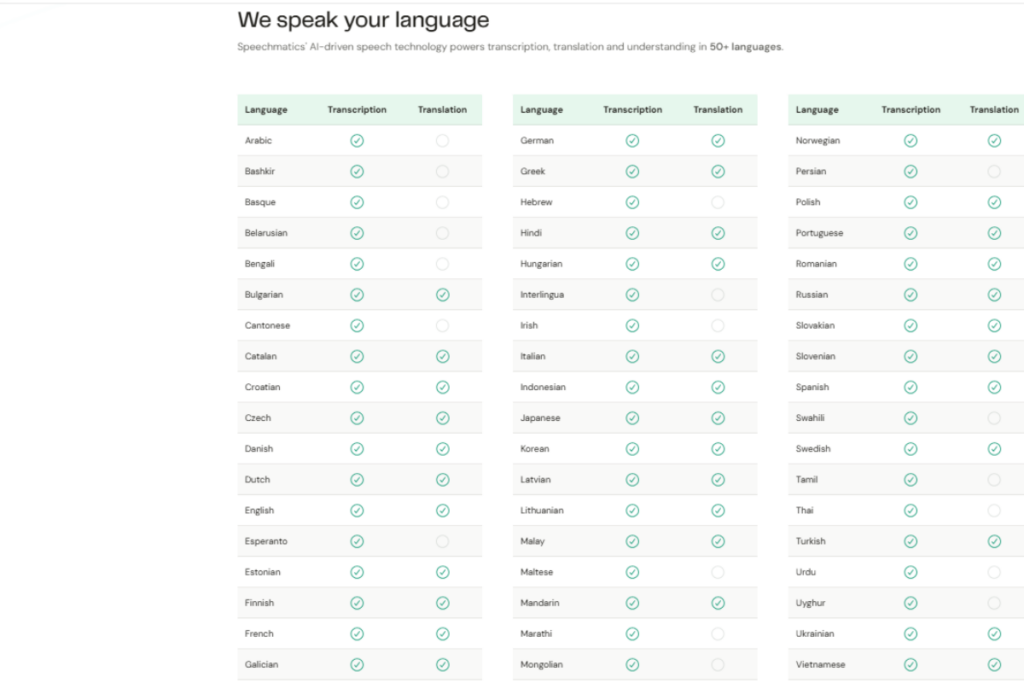
Speechmatics supports transcription in over 30 languages and dialects, including English, Mandarin, Spanish, and French. This feature is invaluable for organizations with global operations or those producing multilingual content.
The ability to accurately process diverse accents and speech patterns ensures that language barriers don’t hinder communication or documentation efforts.
2. Speaker Diarization
This feature identifies and differentiates between speakers in an audio recording, making it especially useful for meetings, interviews, and panel discussions.
Instead of manually tagging speakers, Speechmatics automates this process, saving time and reducing errors. I find this feature incredibly helpful when analyzing team discussions or client calls, as it ensures clarity in the transcription.
3. Noise Adaptation
Speechmatics is equipped to handle challenging audio environments, such as background chatter or outdoor noise. Filtering out irrelevant sounds maintains transcription accuracy even in less-than-ideal recording conditions.
This makes it a reliable option for industries like customer support or journalism, where recordings are often made in unpredictable settings.
4. Custom Vocabulary
Users can add industry-specific terms, jargon, or proper nouns to the transcription model, improving accuracy for specialized applications.
For example, legal professionals can include technical terms, while healthcare providers can ensure medical terminology is transcribed correctly. This feature makes speechmatics adaptable to niche requirements, a significant advantage over generic transcription tools.
5. Real-Time and Batch Transcription
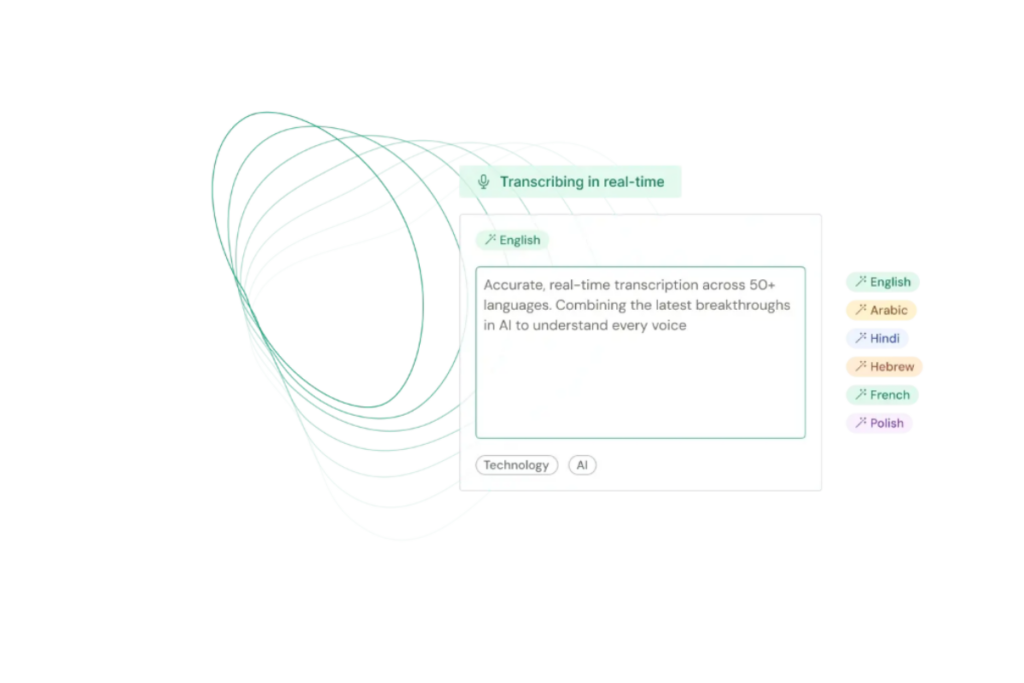
Whether you need live transcription during an event or want to process large audio files in bulk, Speechmatics supports real-time and post-event workflows.
This flexibility allows businesses to use the tool for various scenarios, from live captioning webinars to efficiently converting hours of recorded content into text.
6. Punctuation and Formatting
Speechmatics includes automatic punctuation and formatting capabilities, producing transcripts that are easier to read and understand. This eliminates the extensive manual editing needs, saving users significant time and effort. For professionals who rely on polished documentation, this feature adds considerable value.
7. Seamless Integration Through APIs
The tool offers API-based integration, enabling businesses to embed Speechmatics into their existing workflows or software systems. This is particularly useful for developers or enterprises looking to customize transcription solutions without disrupting their operations.
8. Cloud and On-Premise Deployment Options
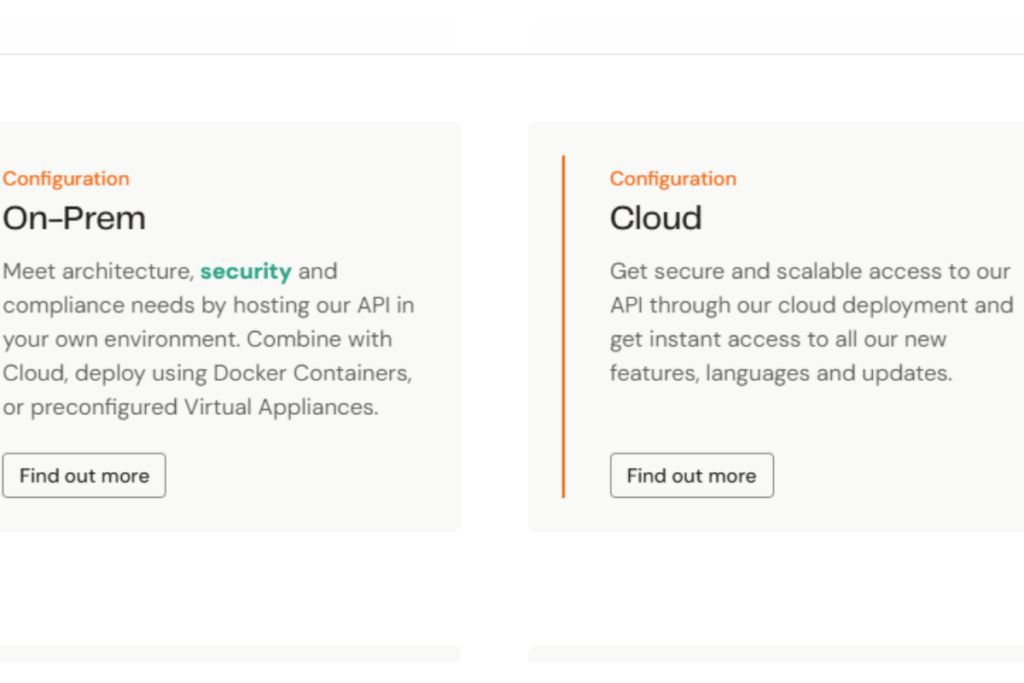
Speechmatics can be used in the cloud or on-premise, depending on the organization’s needs.
Cloud deployment is ideal for those seeking scalability and remote access, while on-premise solutions provide greater control and data security for sensitive information. This flexibility ensures the tool aligns with varying business models and compliance requirements.
9. Analytics and Insights
For businesses focused on extracting insights from conversations, Speechmatics offers analytics capabilities. By combining transcription with data analysis, users can identify trends, monitor customer sentiment, or improve operational efficiency.
Speechmatics combines these features into a comprehensive transcription solution, making it a powerful tool for businesses and professionals across industries. Whether the goal is accuracy, efficiency, or adaptability, these capabilities ensure Speechmatics remains a top contender in the speech-to-text space.
Speechmatics Pricing
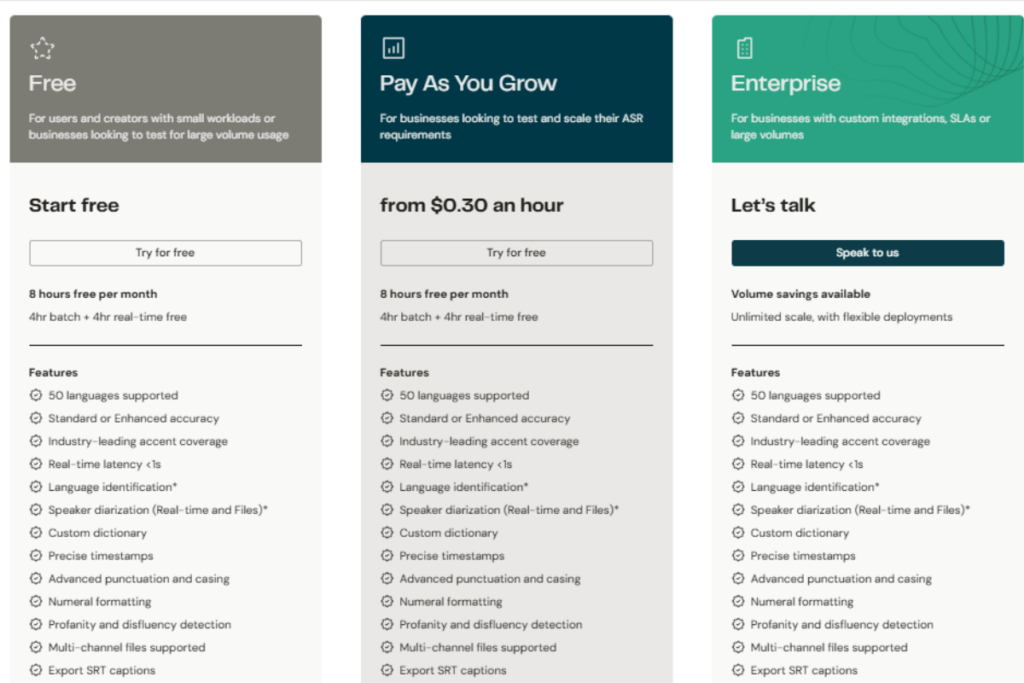
Speechmatics provides flexible pricing options to meet the various needs of individuals, small businesses, or large organizations. Its structure allows users to start with minimal costs and scale as their requirements grow. Below is a breakdown of the available pricing plans:
| Plan | Description |
|---|---|
| Free | For light workloads or testing the platform before scaling up. Features: 8 hours free per month (4 hours batch + 4 hours real-time) 50 languages supported Standard or Enhanced accuracy Accent coverage Real-time latency <1 second Speaker diarization (real-time and files)* |
| Pay As You Grow | Designed for businesses scaling their transcription needs. Pricing: Starts from $0.30/hr. Free Benefits: 8 hours free per month (4 hours batch + 4 hours real-time). Batch Transcription: $0.30/hr for Lite Mode (Standard accuracy) $0.80/hr for Standard accuracy $1.04/hr for Enhanced accuracy Real-Time Transcription: $1.04/hr for Standard accuracy $1.35/hr for Enhanced accuracy Add-ons: $0.65/hr for Translation $0.18/hr for Summaries $0.40/hr for Chapters $0.12/hr for Sentiment $0.20/hr for Topics Features: Includes all Free Plan features plus: 10 concurrent real-time sessions 10 batch jobs per second Online email support |
| Enterprise | For organizations needing advanced integrations or large-scale usage. Pricing: Custom quotes available, with volume discounts. Features: Unlimited scale with no rate limits Multiple deployment options: SaaS, private cloud, on-device Custom models and language adaptation Choice of cloud regions (US, EU, Australia) Dedicated Customer Success and Sales Engineer support Access to early features and personalized services |
Speechmatics Use Case
Speechmatics is a versatile tool designed for various industries. It provides advanced transcription capabilities and the flexibility to adapt to diverse requirements.
Ideal Use Cases
Media and Broadcasting
Media companies benefit from using Speechmatics to produce accurate subtitles and captions in multiple languages.
- Example: A broadcasting company transcribing interviews in different languages for audience accessibility.
- Benefit: Reliable language coverage ensures inclusivity and engagement.
Education
Educational institutions use Speechmatics to convert lectures and discussions into written formats.
- Example: A university transcribing recorded classes to support students with accessibility needs.
- Benefit: Simplifies the review process for learners and enhances accessibility.
Customer Support and Call Centers
Businesses analyzing customer interactions gain insights from accurate transcriptions and speaker differentiation.
- Example: A call center using transcriptions to monitor agent performance and understand customer concerns.
- Benefit: Improves decision-making and service quality.
Legal and Compliance
Speechmatics provides precise transcription for legal proceedings and compliance documentation.
- Example: A legal team documenting courtroom sessions and depositions.
- Benefit: Reduces errors in critical records and ensures compliance.
Where It May Not Be the Best Fit
- Budget-Conscious Users: Smaller teams or freelancers might find the pricing structure challenging to align with their financial limitations.
- Specialized Language Requirements: Performance for niche or rarely spoken languages may vary, making it less ideal for such needs.
- Organizations with Limited Resources: Processing larger files may require more infrastructure than some smaller setups can manage.
Speechmatics demonstrates its adaptability and strength across various industries, providing common and complex transcription needs solutions. Users can leverage its features effectively, provided their use cases align with the platform’s offerings.
Speechmatics Support
Speechmatics combines an accessible interface with dependable customer support, making it a practical choice for users with varying experience levels. The design, onboarding, and available assistance contribute to a user-friendly experience.
Ease of Use
The Speechmatics interface prioritizes simplicity, allowing users to upload files, configure settings, and access transcriptions with minimal effort. The dashboard is logically organized, making it easy for technical and non-technical users to explore.
The onboarding process is straightforward, with step-by-step instructions and a library of resources, including guides and tutorials.
While basic operations are easy to grasp, users who want to use advanced features, such as API integrations or custom vocabularies, may need additional time to familiarize themselves with these tools. The available resources, however, provide clear explanations to assist with these tasks.
Customer Support
Speechmatics provides multiple options for support, ensuring that users can address their concerns effectively:
- Email Support: Included in all plans, this offers a direct channel for resolving questions and technical issues.
- Documentation and Guides: A comprehensive set of resources is available to help users with everything from setup to advanced configurations.
- Enterprise-Level Assistance: Dedicated customer success managers and sales engineers provide personalized guidance for businesses on the Enterprise plan.
Email inquiries are promptly responded to, and most issues are resolved during standard business hours. Enterprise users benefit from prioritized support, which includes faster responses and proactive assistance for integration and scaling needs.
Speechmatics balances ease of use with strong customer support. The interface is designed for simplicity, while onboarding helps users get started quickly. Resources like documentation and tutorials bridge the gap for more complex features.
The support team’s responsiveness further enhances the overall experience, making Speechmatics a reliable choice for individuals, teams, and enterprises. For those requiring advanced support, the Enterprise plan offers additional benefits tailored to larger-scale operations.
Speechmatics Integrations
Speechmatics offers integration options, allowing businesses to incorporate their transcription capabilities into existing workflows effectively. The tool adapts well to diverse operational needs by supporting API integrations and compatibility with various platforms.
Integration Capabilities
The platform supports API-based integrations, allowing developers to embed transcription functionality into their systems. Some of the key applications include:
- Media Production Tools: Automating subtitles and captions for videos.
- Customer Relationship Management (CRM): Transcribing customer interactions for improved analysis and reporting.
- Call Center Platforms: Enabling live transcription of customer calls for better insights and documentation.
This adaptability enables businesses to streamline tasks, automate repetitive processes, and make data-driven decisions without manual intervention.
Compatibility
Speechmatics works with major operating systems, including Windows, macOS, and Linux, ensuring users can access the tool across multiple devices. Its SaaS deployment allows remote access, making it suitable for distributed teams.
The tool supports private cloud, container-based, and on-device deployments for organizations with specific security or infrastructure needs. These options allow businesses to maintain control over their data while integrating Speechmatics into their workflows.
Enhancing Workflows
Integrating Speechmatics into existing systems reduces manual effort and increases efficiency. Some examples of its application include:
- Media Organizations: Automating captioning and transcription directly within production pipelines, saving time and effort.
- Legal Teams: Creating accurate records of court proceedings or client interviews, improving documentation workflows.
- Educational Institutions: Providing automatic transcriptions of lectures and webinars for students.
Speechmatics delivers versatile integration options through its APIs and broad compatibility with different operating systems.
Whether used in cloud-based or on-premise environments, the platform aligns well with various business needs. These capabilities make it an effective tool for improving media, customer service, and education processes.
Speechmatics FAQs
1. How is Speechmatics priced?
Speechmatics offers a Free plan with 8 monthly transcription hours, a Pay As You Grow plan starting at $0.30 per hour, and an Enterprise plan with custom quotes for more significant needs. Feature add-ons like translation are available for additional costs.
2. What integrations are available with Speechmatics?
Speechmatics integrates with platforms such as media production tools, CRM systems, and call center software via its API. These integrations allow users to incorporate transcription services into their workflows efficiently.
3. What languages are supported by Speechmatics?
Speechmatics supports over 50 languages and dialects, including widely used options like English, Spanish, French, and Mandarin, making it suitable for multilingual applications.
4. What customer support options are available?
Speechmatics provides email support for all plans and offers dedicated customer success managers for Enterprise clients. Detailed documentation and proper user guides are accessible online.
5. Is Speechmatics suitable for smaller teams or individual users?
Yes, Speechmatics caters to smaller teams and individuals through its Free plan for light workloads and the scalable Pay As You Grow plan, which adjusts to varying usage levels.
6. Can Speechmatics be deployed outside the cloud?
Yes, Speechmatics supports on-premise deployments, including private cloud and container-based setups, offering options for organizations with specific security or infrastructure requirements.
Speechmatics Alternatives
Below is a table comparing Deepgram, Vocode, Retell AI, Hey Caden AI, TalkStack AI, and Regal AI Phone Agent with Speechmatics, focusing on features, pricing, and ideal use cases.
| Tool | Key Features | Pricing | Best Fit | Difference from Speechmatics |
|---|---|---|---|---|
| Speechmatics | Supports 50+ languages Advanced speaker diarization Real-time and batch transcription Custom vocabulary options APIs for workflow integration | Free plan, Pay As You Grow starting at $0.30/hr, Enterprise pricing available | Businesses needing transcription in multiple languages with flexible deployment | Focuses on language coverage, accuracy, and deployment flexibility |
| Deepgram | Real-time and pre-recorded transcription Customizable AI models API integration for automation Keyword spotting | Starts at $1.25/hr for pre-recorded, $1.50/hr for real-time transcription | High-volume transcription and custom model requirements | Stronger focus on enterprise-scale solutions and customizable AI |
| Vocode | Real-time voice-to-text transcription Integration with chatbots and IVR systems Voice processing for automated responses | Custom pricing based on usage | Businesses embedding transcription into voice-driven applications | Specialized in interactive voice processing rather than general transcription |
| Retell AI | Audio transcription and summarization Focus on actionable meeting insights Summaries for conversations and meetings | Subscription-based, starting at $10/user/month | Teams needing transcription combined with summarized outputs | Highlights summarization over detailed transcription |
| Hey Caden AI | AI-powered call assistant Real-time transcription with task tracking Integrated scheduling and task management | Subscription-based, starting at $20/user/month | Professionals combining transcription with productivity tools | Focuses on linking transcription with task management |
| TalkStack AI | Call transcription with sentiment tracking Insights for CRM and sales analysis Real-time call analysis | Custom pricing available on request | Sales teams analyzing customer interactions | Call analytics and sales-oriented transcription |
| Regal AI Phone Agent | Automated transcription for calls AI-assisted call routing Integration with customer service platforms | Custom pricing available on request | Customer service teams automating call handling | Specialized in automating call workflows and customer service |
Speechmatics is suited for multilingual transcription with flexibility in deployment. Deepgram excels at enterprise-scale use cases with custom AI options, while Vocode is ideal for integrating transcription with interactive voice systems.
Retell AI focuses on summarizing meetings catering to productivity-driven teams, and Hey Caden AI combines transcription with task management.
TalkStack AI is tailored for sales teams seeking insights from calls, and Regal AI Phone Agent automates call workflows for customer service operations. Each tool aligns with specific needs, offering alternatives to Speechmatics based on unique requirements.
Summary of Speechmatics
Speechmatics is a prominent provider of automatic speech recognition (ASR) technology, founded in 2006 by Dr. Tony Robinson. The company is based in Cambridge, UK, and is known for its advanced transcription solutions that support over 50 languages.
Its offerings cater to industries such as media, education, customer service, and legal services, enabling organizations to achieve accurate and efficient speech-to-text conversions. The company has received funding from investors, including AlbionVC, IQ Capital, and Amadeus Capital Partners, helping it expand its technology and market presence.
To meet diverse business needs, Speechmatics offers flexible deployment options, including cloud-based, on-premise, and hybrid setups. With its focus on scalability, accuracy, and inclusivity, Speechmatics has established itself as a trusted partner for businesses worldwide, continuously advancing its ASR capabilities through innovation and research.
Conclusion
Speechmatics delivers effective automatic speech recognition solutions, offering strengths like multilingual support, real-time transcription, speaker diarization, and flexible deployment options.
Its ability to serve industries such as media, education, legal, and customer service highlights its versatility and practicality. Some areas, like pricing transparency and performance for niche languages, could be improved, but its overall functionality remains impressive.
We recommend Speechmatics for teams and businesses that require accurate transcriptions, broad language support, and seamless integration into existing systems. It offers plans to accommodate various operational needs and scales well for both small and large organizations.
Explore Speechmatics to determine if it aligns with your needs, and share your feedback or experiences with us.